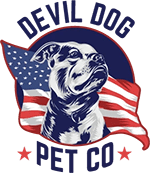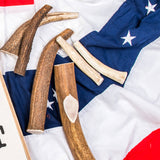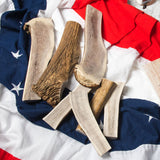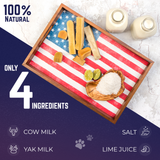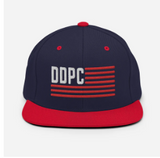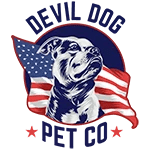The Unfiltered Truth About Elk Antlers: What Every Dog Owner Needs to Know
When our dog Dexter first discovered elk antler chews, it completely transformed our relationship with him. Those marathon chew sessions gave us back our sanity, saved our furniture, and provided him with hours of focused engagement. But I quickly learned that not all antlers are created equal – and the difference between premium and poor quality can mean the difference between a month-long chew fest and a waste of your hard-earned money.
As a Marine veteran, I approach dog ownership the same way I approached my service: with discipline, attention to detail, and an unwavering commitment to doing things right. That's why I'm breaking down everything you need to know about elk antlers – the good, the bad, and the gnarly – so you can make informed decisions for your four-legged family member.
Why Elk Antlers Stand Above Other Dog Chews

Let's cut through the noise: elk antlers are nature's ultimate chew toy. Unlike processed treats that disappear in minutes, quality elk antlers can entertain your dog for weeks or even months. A Medium whole elk antler typically keeps a 40-pound moderate chewer busy for 3-5 weeks of on-and-off sessions, making them the marathoners of the chew world.
But the benefits go far beyond mere longevity. Elk antlers are packed with essential minerals like calcium, phosphorus, zinc, and manganese – nutrients that support your dog's skeletal system and overall health. They're also naturally shed each spring, making them an ethical, sustainable choice that doesn't harm any animals in the process.
Elk Antler Dog Chews vs. Other Options
When comparing elk antler dog chews to other options like rawhide, bully sticks, or synthetic toys, the differences become clear:
- Virtually odorless and mess-free (unlike bully sticks or rawhide)
- No artificial preservatives, chemicals, or dyes
- Naturally shed and sustainably harvested
- Superior longevity – often outlasting dozens of other chews
- Rich in natural minerals that support bone health
One customer's Labrador had demolished every "indestructible" toy on the market until they tried our Monster elk antler. Three months later, that same antler was still going strong, saving them hundreds on replacement toys.
For more detailed insights on the safety and benefits of antlers for dogs, you can visit Are Antlers Good for Dogs to Chew On? and Are Antlers for Dogs Safe?.
Understanding the Different Types of Elk Antlers for Dogs
Not all elk antlers are the same, and choosing the right type makes all the difference in your dog's experience. At Devil Dog Pet Co, we offer two primary varieties: whole antlers and split antlers.
Whole Elk Antlers
These are the iron-tough marathon chews that power through even the most determined gnawers. The dense outer wall forces slow grinding, making them perfect for dogs who've mastered the art of destruction. A whole antler's intact structure preserves all the natural minerals while maximizing durability.
Whole antlers are ideal for experienced chewers who understand how to work an antler properly – gnawing the sides rather than chomping down from above. They represent the ultimate value in terms of chew-hours per dollar spent.
Shop our premium selection of Whole Elk Antler Dog Chews for the toughest chewers.
Split Elk Antler Chews
Split antlers expose the nutrient-rich marrow inside, making them more immediately rewarding for dogs who need extra motivation. Think of them as the "gateway antler" – perfect for puppies with adult teeth (typically 5+ months old), senior dogs, or picky chewers who need instant flavor gratification.
While splits don't last quite as long as whole antlers, they offer a different kind of value by providing both the hard outer layer and the softer, more flavorful inner core. Many of our customers keep both types on hand – splits for quick flavor hits and wholes for marathon chewing sessions.
Explore our variety of Split Elk Antler Dog Chews to find the perfect starter chew.
Deer vs Elk Antler: What's the Difference?
While both deer and elk antlers make excellent dog chews, there are notable differences between them. Elk antlers are generally larger, denser, and more durable than deer antlers, making them better suited for medium to large breeds or power chewers. The density of elk antlers also means they typically last longer, providing better value over time.
Deer antlers, while still excellent chews, tend to be smaller and slightly less dense. They're often a good choice for smaller dogs or more moderate chewers. At Devil Dog Pet Co, we focus primarily on elk antlers because they offer the maximum durability and value for most dogs.
How to Choose the Right Elk Antler for Your Dog

Selecting the appropriate size and type of elk antler is crucial for both safety and satisfaction. Here's how to get it right the first time:
Size Matters – A Lot
The most important rule: bigger is safer and lasts longer. Always choose an antler that's longer than your dog's muzzle and thick enough that it can't fit between their back molars. This prevents your dog from crunching down with full jaw force, which is how most antler problems occur.
For reference, a 20-pound dog typically needs at least a Medium antler, while dogs over 50 pounds should start with Large or XL sizes. When in doubt, size up – an oversized antler is always safer than one that's too small.
Matching Antler Type to Chewing Style
Understanding your dog's chewing habits is key to selecting the right antler:
- Power Chewers: Choose whole antlers in larger sizes; consider going up 1-2 sizes from recommendations
- Moderate Chewers: Either whole or split antlers work well; follow size guidelines
- Picky or Hesitant Chewers: Start with split antlers to provide immediate access to flavorful marrow
- Puppies (with adult teeth): Oversized split antlers under supervision
- Senior Dogs: Split antlers or soaked split antlers for easier access
At Devil Dog Pet Co, our motto is simple: "It is an honor to serve you and your pup." We are dog lovers and dog parents first and business owners second. Because of this, we only work with the best suppliers and the best antlers produced by nature. We only sell Grade A+ elk which represents less than 5% of all antler sold and is the highest quality antler chew you can give your pup.
The Mountain Dog Chews Difference
Unlike mass-market antlers that might sit in warehouses for months or years, our elk antler dog chews are carefully selected, with each piece individually inspected for quality, density, and safety. We source exclusively from naturally shed Rocky Mountain elk antlers, collected by local shed hunters who hike the backcountry each spring.
Our chews are 100% ethically sourced in the USA and cruelty-free. We never use bleach, dyes, or other chemicals – just pure, natural antler exactly as nature intended.
Introducing Your Dog to Elk Antlers: The Right Way
When I first handed our dog Dexter an elk antler, he gave me a look that said, "What am I supposed to do with this rock?" The truth is, many dogs need a proper introduction to antler chews. Unlike the instant gratification of a bully stick, antlers require a bit of canine commitment before revealing their full potential.
Start by rubbing a small amount of peanut butter or bone broth on the antler's surface to pique interest. Hold one end while your dog investigates the other. This interactive approach builds value and teaches appropriate chewing technique. Once your dog understands the concept, they'll likely develop a lifelong appreciation for these premium chews.
Setting Up for Success with Elk Antler Dog Chews
The key to a positive antler experience lies in proper supervision and setup. Create a designated chewing zone with a comfortable mat or bed where your dog can settle in for extended gnawing sessions. This not only protects your floors but also helps your dog understand that antler time is special time.
During the first few sessions, limit chewing to 15-20 minutes to prevent jaw fatigue and keep the novelty high. As your dog builds jaw strength and technique, you can gradually extend these sessions. Remember that antler chewing should be enjoyable, not exhausting.
Safety First: Maximizing Benefits While Minimizing Risks

Like any dog product, elk antlers require responsible ownership. The number one rule with antler chews is proper sizing. An appropriately sized antler forces your dog to gnaw sideways rather than chomping down with their back molars. This sideways gnawing action is safer for teeth and more effective at wearing down the antler gradually.
Always supervise antler chewing sessions, especially with new dogs or when introducing a new antler. Watch for proper chewing technique – if your dog attempts to bite down with full force rather than grinding the sides, temporarily remove the antler and reintroduce it with guidance.
When to Replace an Elk Antler
Even the most durable elk antler dog chew eventually needs replacement. Retire an antler when:
- It becomes small enough to fit entirely in your dog's mouth
- Deep cracks develop that could create sharp edges
- The surface becomes excessively rough or jagged
- Your dog loses interest despite reintroduction attempts
A worn nub can become a choking hazard, so it's always better to start fresh when an antler reaches this stage. Many customers find they can get multiple smaller chews from a single large antler by cutting it down as it wears, maximizing their investment.
Elk Antlers for Puppies: Special Considerations
When it comes to elk antlers for puppies, timing is everything. Hold off on full-strength whole antlers until your pup's adult molars have fully erupted – usually around 5-6 months of age. Before that milestone, their baby teeth and developing jaws aren't ready for hardcore chewing.
For teething puppies with adult teeth coming in, oversized split antlers provide a safer introduction. The exposed marrow offers immediate reward while the larger size prevents inappropriate chomping. Limit early sessions to 10-15 minutes under close supervision, and always provide plenty of appropriate alternatives like puppy-specific chews when antlers aren't available.
Antler Bones for Dogs: The Natural Alternative
While technically not bones (antlers are actually modified bone tissue), elk antler chews offer many of the same benefits as recreational bones without the risks associated with cooked bones. They provide the mental stimulation and jaw exercise dogs crave while being far less likely to cause digestive issues if small amounts are ingested.
Unlike traditional bones, elk antlers don't contain fat that can cause pancreatitis, and they don't become brittle with age. The mineral content of antlers supports dental health in ways that manufactured chews simply can't match.
Maximizing Your Elk Antler Investment

Quality elk antlers represent a significant investment in your dog's enrichment, so getting the most value matters. When your dog loses interest in an antler (which happens naturally over time), try these rejuvenation techniques:
- Rinse the antler under warm water to release more scent
- Rub a small amount of low-sodium bone broth on the surface
- Rotate antlers out of circulation for a week, then reintroduce
- Create a shallow groove to give your dog a "starting point"
Many customers maintain an antler rotation system – when one antler loses its appeal, they swap in a different one. This rotation keeps the novelty high and extends the life of each individual chew.
Buy Elk Antlers: What to Look For
When you're ready to buy elk antlers for your dog, quality indicators make all the difference. Premium antlers have a uniform color without bleached areas, feel dense and heavy for their size, and show no signs of cracking or splintering. Avoid antlers that appear chalky, overly processed, or artificially whitened – these are often older, lower-grade products.
At Devil Dog Pet Co, we only sell Grade A+ elk which represents less than 5% of all antler sold and is the highest quality antler chew available. Our rigorous selection process ensures you're getting fresh, naturally shed antlers with maximum density and mineral content.
The Environmental Impact of Elk Antler Dog Chews
Unlike many dog products that contribute to environmental problems, elk antlers for dogs represent sustainable, ethical pet care. Elk shed their antlers naturally each spring as part of their annual growth cycle. Shed hunters collect these dropped antlers from the forest floor, leaving the elk completely unharmed.
This natural cycle makes elk antler chews one of the most environmentally responsible choices for conscientious pet owners. No animals are harmed, no habitat is destroyed, and the antlers would otherwise simply decompose in the forest. By choosing naturally shed antlers, you're supporting sustainable practices while giving your dog an exceptional chewing experience.
Elk Ears vs. Elk Antlers: Understanding the Difference
Some customers confuse elk ears (a consumable treat) with elk antlers (a long-lasting chew). Elk ears are similar to pig ears – they're dried, edible treats that dogs typically consume in one sitting. Elk antlers, by contrast, are dense, mineralized tissue meant for extended chewing rather than consumption.
While both products have their place, they serve completely different purposes in your dog's enrichment routine. Antlers provide weeks or months of mental stimulation and dental benefits, while ears offer a quick, high-value reward that's gone in minutes.
Our chews are 100% ethically sourced in the USA and cruelty-free. We believe responsible ownership begins with choosing products that align with your values – and for us, that means premium quality without compromise.
Deer vs Elk Antler: Making the Right Choice

When shopping for antler dog chews, you'll often encounter both deer and elk options. While similar in composition, these aren't interchangeable products. Elk antlers typically offer greater density, durability, and size compared to deer antlers. This makes elk antlers for dogs the superior choice for moderate to aggressive chewers who need something substantial to work on.
The difference becomes apparent in longevity. A premium elk antler chew often outlasts a deer antler by weeks or even months, depending on your dog's chewing style. The increased density also means more minerals delivered over a longer period – making elk antlers a better value despite their higher initial cost.
Moose Antler Chews for Dogs: The Giant Alternative
For truly massive power chewers, moose antler chews for dogs represent the next step up from elk. These enormous paddles provide even more surface area and density than standard elk antlers. However, they're significantly less common in the marketplace due to limited supply.
Moose shed their impressive antlers annually just like elk, but their more limited range and population means fewer sheds are collected each year. If you're lucky enough to find genuine moose paddles for your power chewer, they can provide exceptional longevity – though expect to pay a premium for these rare finds.
Mountain Dog Chews: The Elevation Factor
Not all elk antlers are created equal. Those sourced from high-elevation Rocky Mountain regions typically offer superior density compared to antlers from lowland elk. This is due to the mineral-rich diet and challenging environment these majestic animals navigate.
When we first introduced Dexter to a premium Rocky Mountain elk antler, the difference in his engagement level was immediately apparent. The increased density and mineral content seemed to trigger a more instinctual response – as if he recognized the superior quality on a primal level.
At Devil Dog Pet Co, our motto is simple: "It is an honor to serve you and your pup." We are dog lovers and dog parents first and business owners second. Because of this, we only work with the best suppliers and the best antlers produced by nature. We only sell Grade A+ elk which represents less than 5% of all antler sold and is the highest quality antler chew you can give your pup.
Elk Antlers for Sale: Understanding Pricing
The wide price variation in the elk antler market often confuses first-time buyers. Premium elk antlers for sale typically command higher prices for good reason – they're fresher, denser, and carefully selected for quality. Lower-priced options often use older sheds that have weathered longer in the elements, resulting in less density and nutritional value.
When evaluating elk shed antlers for sale, consider that price often reflects the grading process. Top-tier suppliers like Devil Dog Pet Co invest in rigorous selection processes, rejecting the vast majority of available antlers to offer only those meeting strict quality standards. This selection process ensures your dog gets maximum benefit from every chewing session.
Dog Chewing Antlers Safe: The Leadership Component
Safe antler chewing isn't just about product selection – it's about leadership. Teaching your dog appropriate chewing technique transforms antlers from merely acceptable to truly beneficial. Dogs that learn to gnaw laterally rather than chomping down vertically gain maximum dental benefits while minimizing any risk.
This leadership approach extends to all aspects of antler use. Establishing designated chew times, providing proper supervision, and removing antlers when they become too small are all part of responsible ownership. Remember that every chew session is an opportunity to reinforce your role as provider and protector.
Large Elk Antlers for Sale: Sizing Matters
When seeking large elk antlers for sale, remember that bigger isn't always better – appropriate sizing is what matters most. An ideal antler should be longer than your dog's muzzle but not so massive that they can't comfortably manipulate it. The diameter should prevent your dog from getting the antler between their back molars.
For extreme power chewers, oversized antlers provide both safety and value. These substantial pieces force dogs to work the antler gradually rather than attempting to crush it, extending the life of the chew while protecting dental health.
Elk Antler Dog Treats: The Ultimate Investment
While we often categorize them with treats, premium elk antlers are better understood as enrichment tools that deliver long-term benefits. Unlike conventional treats that provide momentary pleasure, elk antler dog treats offer weeks or months of mental stimulation, dental cleaning, and mineral supplementation.
Our chews are 100% ethically sourced in the USA and cruelty-free. This commitment to ethical sourcing means you can offer these premium chews with complete confidence, knowing they represent the highest standards of both quality and responsibility.
Reindeer Antler Dog Chews: Seasonal Alternatives
While less common than elk or deer options, reindeer antler dog chews occasionally appear in specialty markets. These antlers share many characteristics with elk antlers but tend to be smaller overall due to the animal's size. They make excellent options for smaller breeds or dogs new to antler chewing.
The novelty of these seasonal offerings can reinvigorate interest in chewing for dogs that have become accustomed to standard elk antlers. Many owners rotate between different antler types to maintain engagement and provide varied sensory experiences.
Conclusion: The Lasting Value of Premium Elk Antlers
Elk antler chews are one of the smartest investments you can make for your dog's health and happiness. With superior durability, natural minerals, and eco-friendly sourcing, they stand out as a top choice for both mental stimulation and physical wellbeing.
At Devil Dog Pet Co, we offer only the finest Grade A+ elk antlers—the top 5% available. Ethically sourced and crafted for maximum benefit, our chews reflect your commitment to responsible pet care.
For more on responsible dog ownership and maximizing your dog's enrichment, check out our dog care tips, learn how to help dogs with anxiety.
Download the FREE 10-Step Dog Prep Guide
Frequently Asked Questions
Do elk lose their antlers each year?
Yes, elk naturally shed their antlers every year, typically in late winter or early spring. This process allows them to grow a new, often larger set of antlers for the following mating season. The shedding is influenced by changes in daylight and hormone levels, making it a regular annual cycle.
What is unique about the elk's antlers?
Elk antlers are unique because they can grow up to several feet long and weigh up to 40 pounds. Unlike horns, which are permanent, elk antlers are made of bone and are shed and regrown annually. Their impressive size and intricate branching make them a symbol of strength and vitality in the animal kingdom.
How much are elk antlers worth?
The value of elk antlers varies widely depending on size, quality, and whether they are naturally shed or taken from hunted animals. Naturally shed antlers can sell for anywhere from $50 to several hundred dollars each, especially if they are large and well-preserved. Antlers used for decorative, medicinal, or pet chew purposes may also influence their market price.
Why do vets not recommend antlers?
Veterinarians often caution against giving antlers to pets because they are extremely hard and can cause dental damage, such as broken teeth. Additionally, splinters from antlers can pose choking hazards or cause internal injuries if ingested. Safer chew alternatives are usually recommended for maintaining pet dental health.
Why don't you find antlers in the woods?
Finding antlers in the woods can be surprisingly rare because many animals and insects consume the shed antlers as a valuable source of calcium and nutrients. Also, weather conditions and human collection reduce the chances of spotting antlers lying around. They tend to break down or disappear quickly after being shed.
Is shedding antlers painful?
Shedding antlers is generally not painful for elk because the process involves a natural weakening of the tissue at the base of the antlers. This allows them to fall off easily without causing injury. Elk may rub their antlers against trees to help the shedding process, but this behavior is normal and not associated with pain.
